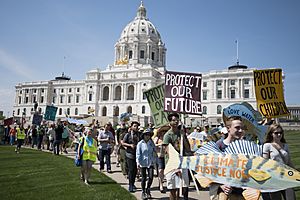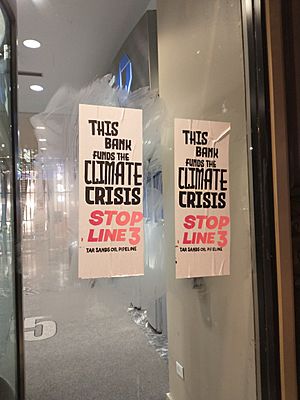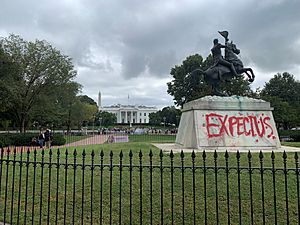Line 3 pipeline facts for kids
Quick facts for kids Line 3 Pipeline |
|
|---|---|
| Location | |
| Country | Canada United States |
| From | Hardisty, Alberta |
| To | Superior, Wisconsin |
| General information | |
| Type | Crude oil |
| Owner | Enbridge |
| Commissioned | 1968 |
| Technical information | |
| Length | 1,659 km (1,031 mi) |
| Line 3 Replacement (Canada Segment) |
|
|---|---|
| Location | |
| Country | Canada |
| General information | |
| Type | Crude oil |
| Status | Complete |
| Commissioned | December 2019 |
| Website | Canada segment |
| Line 3 Replacement (U.S. Segment) |
|
|---|---|
| Location | |
| Country | United States |
| General information | |
| Type | Crude oil |
| Status | Complete |
| Construction started | December 2020 |
| Commissioned | October 2021 |
| Website | U.S. segment |
The Line 3 pipeline is a long oil pipeline owned by a large Canadian company called Enbridge. It has been moving crude oil since 1968. The pipeline stretches about 1,659 kilometers (1,031 miles) from Hardisty, Alberta, Canada, all the way to Superior, Wisconsin, in the United States.
Over the years, there have been worries about how safe the pipeline is. This is because it has caused many oil spills. One very serious spill happened in 1991 near Grand Rapids, Minnesota. It was the biggest inland oil spill ever in the U.S. Because of these safety concerns, Enbridge decided to carry less oil through the old pipeline.
In 2014, Enbridge suggested building a brand new pipeline. This new pipeline would follow a slightly different path in Minnesota. It would also allow them to move much more oil. The new pipeline has now been finished in Canada, Wisconsin, North Dakota, and Minnesota. However, getting permission and building the new pipeline faced a lot of opposition. Many Native American communities and groups working for climate justice were against it.
History of the Pipeline
The original Line 3 pipeline started working in 1968. It was first owned by the Lakehead Pipeline Company. This pipeline is 34 inches wide and 1,031 miles long. It moves crude oil from Hardisty, Alberta, to Superior, Wisconsin. The pipeline was not fully checked for problems until after 1976.
Oil Spills and Their Impact
From the 1970s until 1991, the Line 3 pipeline had 24 leaks. These leaks were all caused by the same type of problem in the pipeline's seams. These leaks led to 16 "large oil spills." About four million gallons of oil were spilled in total. Officials in Minnesota believed that about 5.7 million gallons had spilled from the pipeline between 1971 and 1992.
One big spill happened in 1973 near Argyle, Minnesota, releasing 1.3 million gallons of oil. Then, on March 3, 1991, the Line 3 pipeline broke in a wetland near Grand Rapids, Minnesota. This spill released 1.7 million gallons of crude oil into the Prairie River. This river flows into the Mississippi River. It was the largest inland oil spill in U.S. history. At the time of the 1991 spill, the pipeline carried 22 million gallons of oil every day.
Building a New Pipeline
Over time, the old pipeline developed many cracks and holes. Because of these problems, Enbridge reduced the amount of oil it carried each day. In 2014, Enbridge announced plans to build a new Line 3 pipeline. This big project would cost billions of dollars. It would allow Enbridge to move almost 800,000 barrels of oil per day again. By 2016, parts of the new pipeline in Canada, North Dakota, and Wisconsin were approved. Construction of the new Line 3 was finished everywhere except Minnesota by November 2020.
Getting permission for the pipeline was harder in Minnesota. Groups working for environmental justice, Native American communities, and government agencies were against the project. Enbridge agreed to a new route for the replacement line. This new path avoided sensitive water areas and some Native American reservations. In 2018, the Minnesota Public Utilities Commission (PUC) asked for public opinions. Out of nearly 70,000 comments, 94% were against the pipeline. Still, in June 2018, the PUC approved Enbridge's new route. They also gave the company the necessary permits to build the pipeline.
By December 2020, Minnesota state and federal groups had given Enbridge all the permits needed. These permits allowed them to build the last part of the Line 3 pipeline through Minnesota. Even though some permits were still being challenged in court, construction began in December 2020. The Biden administration supported the pipeline. However, the pipeline still faced strong opposition until it was finished in September 2021. The new pipeline started working on October 1, 2021.
Continued Protests and Opposition
Even after the pipeline was approved, several groups continued to challenge it in court. These included Ojibwe tribes, environmental groups, and the Minnesota Department of Commerce. In March 2021, the Minnesota Court of Appeals heard arguments. Those against the pipeline questioned if there would be enough demand for the oil to justify building Line 3.
Outside of court, Indigenous-led groups organized many protests against Line 3. They used non-violent actions to try and stop construction. Groups like the Giniw Collective and Honor the Earth held dozens of protests. Thousands of people attended these events. By April 2021, over 200 people had been arrested for protesting. When the pipeline was finished, nearly 900 people faced charges related to these protests.
On June 7, 2021, protesters called "water protectors" gathered at the White Earth Indian Reservation. About 2,500 people attended. They then took action at an Enbridge pumping station. Over 200 protesters occupied the station and blocked access. Police then arrested 247 people. Most were charged with trespassing.
On Indigenous Peoples' Day (October 11, 2021), a statue of Andrew Jackson in Washington, D.C., was spray-painted with the words "Expect Us." Protesters had been chanting "respect us or expect us." This was part of the protests against the Line 3 pipeline. Indigenous tribes are worried the pipeline could spill and harm their land. This land is important for hunting, fishing, gathering, and farming.
Debates in Minnesota
Why People Oppose Line 3
Concerns About Climate Change
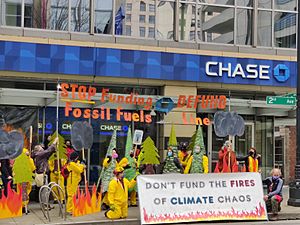
A major reason for opposing Line 3 is worry about climate change. Groups like the Sierra Club and Honor the Earth have campaigns to "Stop Line 3." An Environmental Impact Statement (EIS) looked at the pipeline's effects. It showed that the new Line 3 pipeline could lead to deforestation. It could also increase pollution risks to Minnesota's clean water and wild rice beds. Most importantly, it would create greenhouse gases that cause climate change.
One study by climate justice groups found that the greenhouse gas emissions from the new Line 3 pipeline would be like building 50 new coal power plants. The EIS estimated that the total cost of these emissions to society would be over $120 billion in 30 years. The Minnesota Department of Commerce formally spoke against the pipeline because of its environmental impacts.
In February 2021, U.S. Representative Ilhan Omar asked President Biden to stop the pipeline. She said the decision on Line 3 affects the whole world. She urged him to make a choice that supports science on climate change. She also noted the pipeline would add five times more greenhouse gas each year than Minnesota's transportation did in 2016.
Risks of Oil Spills
Many people are concerned about possible oil spills from Line 3. The original pipeline caused the largest ever inland oil spill in the U.S. In 1991, 1.7 million gallons of oil spilled from Line 3 in Grand Rapids, Minnesota. Enbridge was also responsible for a large spill in Michigan in 2010. Cleaning up that spill cost over a billion dollars and took almost ten years.
In total, Enbridge has had over 800 oil spills between 1999 and 2010. These spills have harmed the economy, public health, and the environment. Enbridge says pipeline safety is their main goal. They use technology to watch their pipelines and train staff for emergencies. While big oil spills have decreased, activists in Minnesota say that even one serious spill is too risky. The Environmental Impact Statement for Line 3 agrees that some oil spills are likely and serious ones are possible.
Protecting Ojibwe Treaty Rights
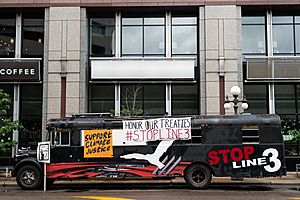
Some Native American communities in Minnesota are against the pipeline because of their treaty rights. Most of the land in northern Minnesota was given to the U.S. through treaties with Ojibwe peoples in the 1800s. These treaties created reservations. They also gave Ojibwe people rights to use the rest of the land for hunting, fishing, and harvesting manoomin (wild rice).
The planned route for the new Line 3 pipeline would cross through this protected land. Several Ojibwe communities say that building the pipeline would break these treaty rights. It would disturb and threaten the resources promised to them on their ancestral land. The Environmental Impact Statement admits that building Line 3 would disturb Native historic and cultural sites, like burial grounds.
Five Ojibwe bands have fought the pipeline project in court. These include the White Earth, Red Lake, Mille Lacs, Fond du Lac, and Leech Lake bands. They all opposed the pipeline. In August 2018, the Fond du Lac band signed an agreement with Enbridge. This allowed the company to route the pipeline through their reservation. The Leech Lake Band also stopped their formal appeals in December 2018. This happened after Enbridge agreed to remove the old pipeline from their reservation if the new one was built.
What Happens to the Old Pipeline?
The agreement with the Leech Lake Band brings up another debate. What will happen to the old Line 3 pipeline if a new one is built? Enbridge calls their process "deactivation." Many who oppose the project call this "abandonment." Enbridge says deactivation involves five steps: removing the oil, cleaning the pipe, disconnecting it, adding corrosion controls, and leaving the pipe in the ground.
Groups like Minnesotans for Pipeline Cleanup worry that pollutants might remain after the cleanup. Many landowners along the old route are concerned they will have to pay for the old pipe. This could be for cleanup, removal, or lost property value. Reports mention that Line 3 would be the first pipeline ever to be decommissioned in Minnesota. People worry about what kind of example this might set for future projects.
Why People Support Line 3
Creating Jobs
Supporters of Line 3 say that building the pipeline will create jobs. A study from the University of Minnesota Duluth in 2017 claimed the project would create thousands of jobs. However, later, journalists found that a business group funded by Enbridge had paid for the study. Also, Enbridge itself provided the data for it. In the end, a professor involved in the research cut ties with that business group.
While there might not be many long-term jobs, supporters argue that even temporary jobs would help many families in Minnesota. The original EIS also looked at short-term and long-term jobs. It concluded that the pipeline's operation would have "no to negligible impact" on income or unemployment rates in the area. The pipeline's effect on jobs in Minnesota is still debated.
Tax Money for Counties
Line 3 supporters also argue that counties along the pipeline route will benefit from property taxes paid by Enbridge. In its first year, the new pipeline was expected to pay $19.5 million in property taxes. This amount would increase over time. However, those against the pipeline are not convinced. They point to past lawsuits where Enbridge claimed they were overtaxed. This left counties in Minnesota owing tens of millions of dollars.
Helping the Oil Industry
Building the Line 3 pipeline would help the Canadian oil industry. It would allow them to produce more oil and keep prices stable. Enbridge says Line 3 would help meet the needs of Minnesota's oil refineries. Many other companies also want the pipeline built. Line 3 is seen as very important for the Canadian oil industry. It has been hard to move oil out of Alberta, which has led to less production and lower prices. Thousands of Canadians have lost jobs in the oil industry because of these problems.
Also, companies that cannot ship their oil through pipelines might use trains instead. Recent studies show that transporting oil by train leads to more spills than by pipeline. The Prime Minister of Canada, Justin Trudeau, supported Line 3 for this reason:
(Transport of oil by rail) is less economic, more dangerous for communities, and creates more greenhouse gas emissions than modern pipelines would be.
Enbridge believes Line 3 would replace more than 10,000 rail cars carrying oil every day. The group Minnesotans for Line 3 says that approving the pipeline would make oil transport safer. However, the Minnesota Department of Commerce questioned these ideas. They claimed that these projections do not consider all possible future demands for oil.
See also
- List of oil pipelines
- List of pipeline accidents in the United States in the 21st century


